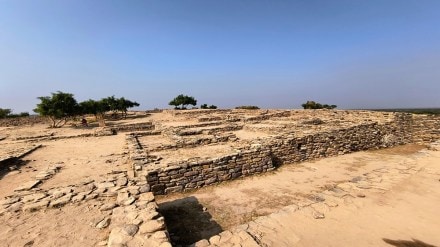The area around Dholavira in Gujarat is so pristine that when we decided to explore the ruins of this ancient city, the aim was to leave minimum carbon footprint, and that could only have been achieved with an electric car.
But driving an electric car in the middle of nowhere can be risky – where to find chargers? Unless it’s a car with a good range, like the Hyundai Creta Electric.
Where is Dholavira?
Located in the north of Gujarat, in the Kutch district (officially spelled as Kachchh), Dholavira is among the southernmost points of the Indus Valley Civilisation (also called the Harappan Civilisation).
It is the newest Harappan city to have been found (by JP Joshi in 1967-68) – Joshi was the archaeologist who served as the director general of the Archaeological Survey of India from 1987 to 1990.
But it isn’t on the Indus …
It isn’t, and yet is considered part of the Indus Valley Civilisation because of its architectural, cultural, and design similarities with other Indus Valley cities such as Harappa and Mohenjo-daro (now in Pakistan).
What’s called the Indus Valley Civilisation today wasn’t spread only on the Indus River, but the entire region. Dholavira, for example, is located on the Luni River, which originates in Rajasthan. There are sites further south that are located on the Arabian Sea, such as Lothal. And cities in the north such as Kalibangan (on the banks of the Ghaggar River) and excavations near Ropar (on the Sutlej).
What makes it unique?
Most of the artifacts excavated in Dholavira are kept at the Archaeological Museum Dholavira, located near the excavation site – including pottery, tools, beads, and seals that are almost 3,000 years old. This is unlike the most famous Indus Valley cities of Harappa and Mohenjo-daro, whose artifacts are kept at the British Museum in London, the National Museum of India in New Delhi (the famous Dancing Girl figurine is kept here), and the National Museum of Pakistan in Karachi (the Priest-King sculpture can be found here).
How to reach?
You can either drive from Ahmedabad (7 hours, 340-km), or from Bhuj (3 hours, 130-km). Both cities have an airport.
The Road to Heaven
The drive from Bhuj to Dholavira is spectacular – it takes you via what is called the Road to Heaven. It’s a straight road for kilometres with salt flats and water all around, and you can spot flamingos in the winters. The place is also usually free of tourists. The water body is so huge that it looks like an ocean, and the salt flats are so vast that they look like the Antarctic icesheet.
Where to stay?
The nearest major city is Bhuj, which has plenty of 3-star and 4-star hotels. But if you are visiting in the winters (November to March), you must stay in Dhordo (90 km from Dholavira) where you will find plenty of tents and homestays. The winters are also the time when the annual Rann Utsav runs in this part of Kutch – a carnival of music, dance, and natural beauty (visit on a full moon day is worth it).
What to eat?
Kutchi dabeli is a popular street food. Kutchi thali is also a must-try – the flavour matches southern Rajasthani cuisine, and is vastly different from the ‘sweet’ Gujarati food.
Almost every roadside eatery serves mawa – a sweetmeat made from milk thickened by heating in an open iron pan, and topped with dry fruits, spices, and rose petals.
How’s the Creta Electric?
It’s available in two battery-pack options – 42-kWh priced Rs 17.99-20.88 lakh, and 51.4-kWh priced Rs 21.5-24.38 lakh. We picked up the 51.4-kWh model because it has a long range of almost 400 km. It can also be charged overnight using a regular three-pin plug at multiple hotels around this region.
How does it drive?
The first thing you’d notice is that the steering wheel doesn’t have the Hyundai logo, but has four dots in a row, representing letter ‘H’ in Morse code. The gearlever has moved from the central console to the right side of the steering wheel (as a stalk) – and needs to be flicked to go from P to N to R. We found it tricky, but after a day of driving we got used to it.
Because the floor has the battery pack, the seating position is high. The suspension feels a bit stiff (for the extra battery weight), and on broken roads the ride feels a bit harsh. On smooth roads, it’s really quiet. Throttle response is different in Eco, Normal, and Sport modes. In the Sport mode, the Creta Electric turns maniac – 0-100 km/h in just 7.9 seconds, and from any speed to any speed in the blink of an eye.
Rear-seat comfort is good, and there is a 3-pin socket to charge a laptop if you want to work.
Why visit Dholavira?
A couple of months ago, President of India Droupadi Murmu visited the UNESCO World Heritage Site of Dholavira. You should visit because, for now, Harappa and Mohenjo-daro are out of bounds (because of the India-Pakistan armed conflict), and also because Dholavira is possibly the most well-preserved Harappan archaeological site, showcasing their advanced town planning skills, sophisticated water conservation system, well-structured reservoirs, urban settlements, and so on.
